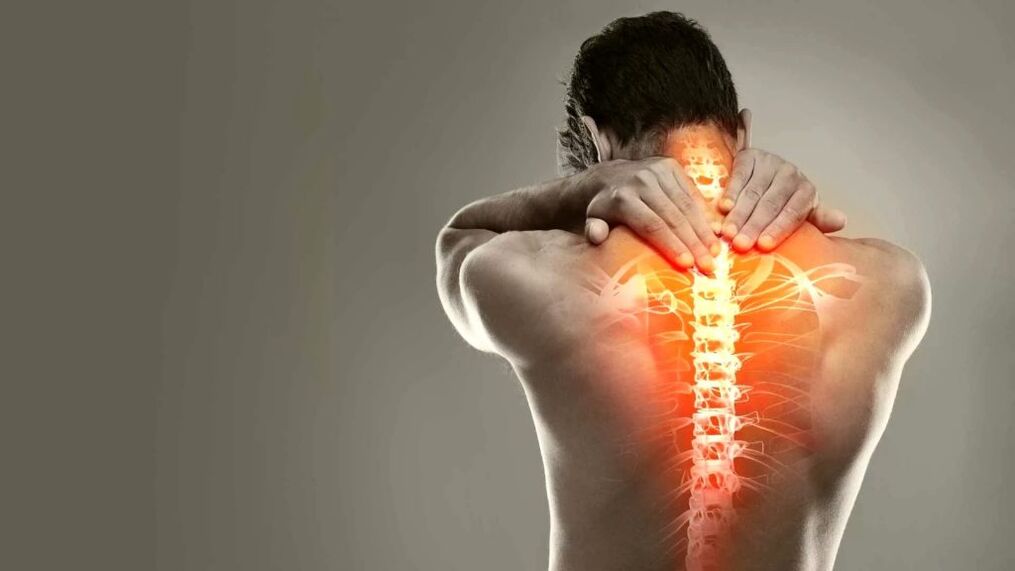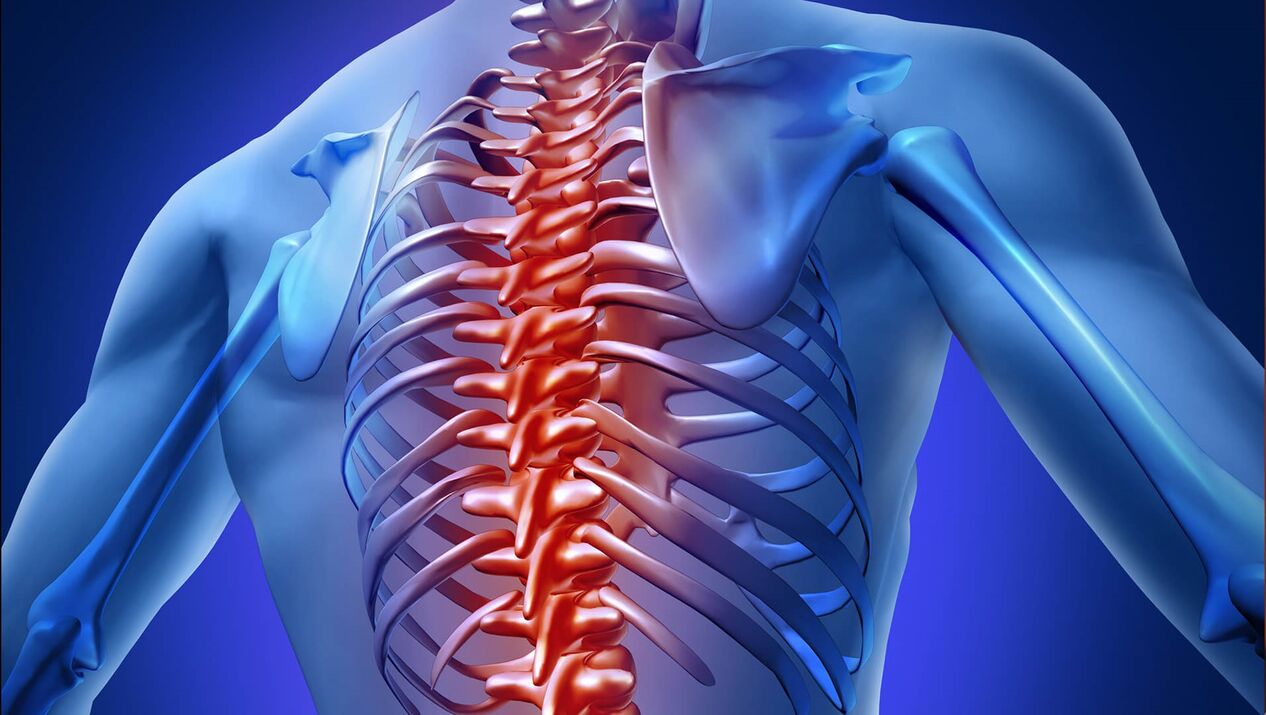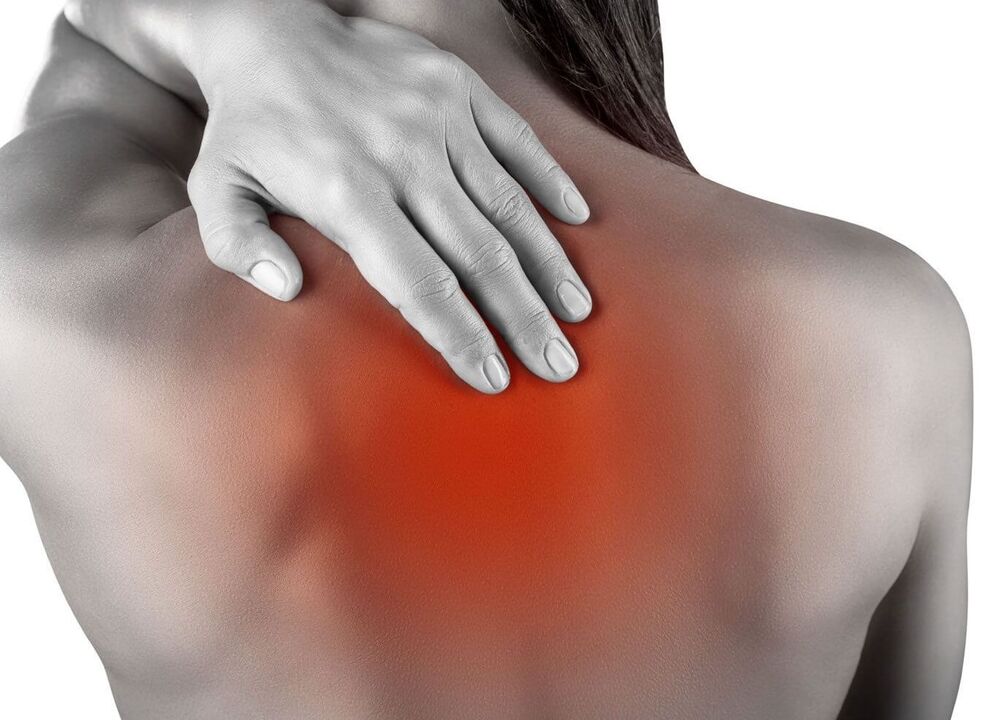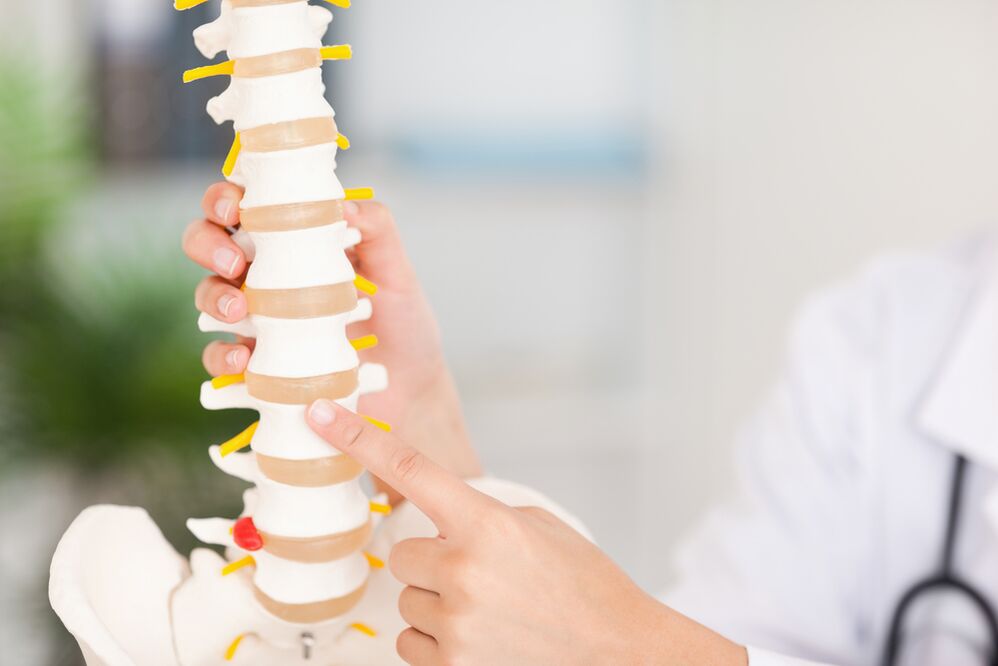
Osteochondrosis - dystrophic and degenerative changes in cartilage and bone tissue. Osteochondrosis of the spine can occur in the cervix, chest or lumbar region. Disease progression leads to destruction of ligaments, joint structure, intervertebral discs.
Osteochondrosis of the spine in the chest is not common. This is due to the peculiarities of its structure. Its mobility is lower than that of the cervix and lumbar region. Part of the load is taken by the ribs and chest. Danger of pathology in the complexity of its diagnosis. The symptoms are similar to other diseases, they appear quite late, which complicates the treatment process.
Causes of the disease

The development of thoracic osteochondrosis is associated with metabolic disorders and increased load on the intervertebral discs. Inside the intervertebral disc is the nucleus pulposus, which is surrounded by the annulus fibrosus. In case of its damage, the core dries out and the amortization properties are lost. Degenerative processes result in inflammation and stretching of nerve fibers in the spinal cord.
Causes of osteochondrosis can be:
- Heredity;
- Intervertebral hernia;
- The presence of osteophytes;
- Poor blood supply to the spinal cord due to vascular strain;
- Disturbance of mineral metabolism (namely, calcium deficiency);
- Curvature of the spine, which creates an uneven load on the discs;
- Trauma to the chest due to falls, bruises, bruises;
- Powerful sports, regular weight lifting;
- Passive lifestyle.
Symptoms and sensations in thoracic osteochondrosis
The clinical picture of pathology is influenced by several factors:
- Level of spinal cord injury;
- Patient's age;
- Stage of pathological process (exacerbation or remission).
The symptoms of thoracic osteochondrosis are characterized by diversity and nonspecificity, so the disease is often confused with other pathologies.
The main signs of breast osteochondrosis:
- Dorsago - A sharp, sudden pain in the chest and spine ("chest lumbago"), the patient feels short of breath.
- Dorsalgia is a minor pain in the affected vertebrae that gradually develops over several weeks. The pain may increase with deep breathing, lateral and forward bending, as well as prolonged stay in a static posture.
Feeling of severe pain in the girdle and breathing problems are associated with intercostal neuralgia, during which the nerve roots are compressed. The intensity of the pain usually increases in the afternoon and disappears after a good night’s sleep.
Neurological symptoms include:
- Impaired sensitivity of the limbs;
- Numbness of the heart muscle;
- Pulmonary syndrome;
- Itching, burning, numbness of the skin;
- Convulsions and muscle spasms;
- Sensation of the presence of a foreign object in the pharynx when osteochondrosis is localized in the upper segment of the chest.
Intercostal neuralgia is a symptom accompanying degenerative-inflammatory pathologies of the spine (osteochondrosis, vertebral displacement, scoliosis). But its appearance resembles the signs of various diseases of the peritoneal organs and the chest region.
ᲨNote!Often the pain occurs in the upper areas of the chest region, gradually covering it completely, as well as around the shoulder blades (reminiscent of angina). Pain in the right hypochondria occurs during osteochondrosis of the middle chest. Their diagnosis may be pancreatitis or cholecystitis. Gastrointestinal tract pain occurs with damage to the lower segment of the thoracic spine, imitating intestinal disease.
Stages of disease development

The degree of development of the disease is associated with pathological disorders of the spine, which are characterized by certain clinical symptoms.
There are 4 periods of disease development:
- 1 degree- The appearance of cracks inside the fibrous ring, after which fluid from the pulp nucleus penetrates into it. There is pain syndrome that is localized only to the affected side. There may be pain in the heart muscle area, muscle cramps.
- 2nd degree- Abnormal mobility occurs between the vertebrae, subluxations are noticeable in the chest area. Excessive discomfort and increased pain are felt during prolonged static posture or movement.
- 3rd grade- Rupture of the annulus fibrosus, which extends beyond the nucleus pulposus. An intervertebral hernia forms. This causes severe pain in the belt, reduced mobility and other symptoms.
- 4 degrees- Abnormal processes go beyond the spinal column. Degenerative-dystrophic changes involve paravertebral ligaments, developing fibrosis.
Diagnosis
Radiography is very informative. The presence of pathology indicates:
- Uneven edges of the disk;
- Expanding and intensifying non-cationic processes;
- Reducing the height of the discs, deforming their shape;
- Existence of osteophytes.
Contrast-enhanced X-ray examination is sometimes performed. The contrast agent fills the destroyed disk, making it possible to determine the degree of neglect of the pathological process. MRI and computed tomography are considered less informative.
Effective treatment
How to treat osteochondrosis of the chest region? The approach to therapy should be comprehensive. It is necessary to take into account the stage of development of the disease, the degree of destructive processes, the general condition of the patient.
Drug therapy
Several groups of drugs are used to treat osteochondrosis of the chest.
- Nonsteroidal anti-inflammatory drugs and muscle relaxants;
- Glucocorticosteroids. Their therapeutic effect is more pronounced than that of nonsteroidal anti-inflammatory drugs, but the risk of side effects is higher.
- Chondroprotectors. Chondroprotective agents are believed to help regulate damaged cartilage tissue. But their effectiveness has not been conclusively proven.
- Diuretics are used to relieve swelling of the narrowed nerve fibers during the exacerbation of osteochondrosis in a short time.
Folk remedies and recipes

It is more often used during the period of remission of the disease and only as an additional method of treatment.
Treatment of osteochondrosis at home using traditional medicine:
- 30-40 g of chopped celery root pour 1 liter of boiling water. Insist 8 hours. Drink 1 dessert spoon three times a day.
- Steam 150 g of lard. Add to it 2 tablespoons of wax. Heat for 15 minutes. Add 1 tablespoon of ammonia. Massage the problem areas twice a day. Store in a cool place.
Massage and exercise therapy
One of the most effective therapeutic measures for osteochondrosis is massage. It helps to eliminate muscle spasm, improve blood supply to the problem area and normalize the functional state of the spinal column. Vibration massage is recommended in case of disease exacerbation. After reducing the clinical manifestations, you can take a classic massage course.
Massage is not recommended for grade 3 chest osteochondrosis when there is an intervertebral hernia. This may worsen the patient's condition.
The goal of physiotherapy and gymnastics during osteochondrosis is to improve the mobility of the intervertebral joints, to strengthen the muscular body. Exercise therapy allows you to relieve muscle spasms, remove stiffness in the spine. Lessons should be conducted daily under the supervision of an experienced instructor. Their plan is compiled individually for each patient.
Power characteristics
Basic principles of proper nutrition in the treatment of chest osteochondrosis:
- Large amounts of protein in the diet;
- Exclude fatty and fried;
- Food must be cooked or baked.
Salt should be excluded from the ration or significantly limited. Avoid carbonated and caffeinated beverages. It is better to replace them with herbal tea, natural juices. To enhance the synthesis of cartilage tissue, it is useful to introduce jellies, jellies, jellies containing chondroitin. To get enough calcium for bone health, you need to consume dairy products. Proper nutrition prevents the progression of the pathological process.
Prevention measures
To prevent the development and aggravation of destructive processes in the thoracic spine, it is recommended to take preventive measures as early as possible and follow them regularly.

Recommendations:
- Do special exercises for the back every day;
- Give up addictions;
- Eat right and balanced;
- Weight normalization;
- You need to warm up for 10 minutes every hour while sitting;
- Swimming, water aerobics;
Chest osteochondrosis is not very common compared to cervical and lumbar canals. But it is no less dangerous for the body with its consequences. It is quite difficult to detect at an early stage, due to the similarity of the symptoms with other pathologies. It is therefore important to constantly monitor the health of the spine to take all measures to prevent abnormal destruction.















































